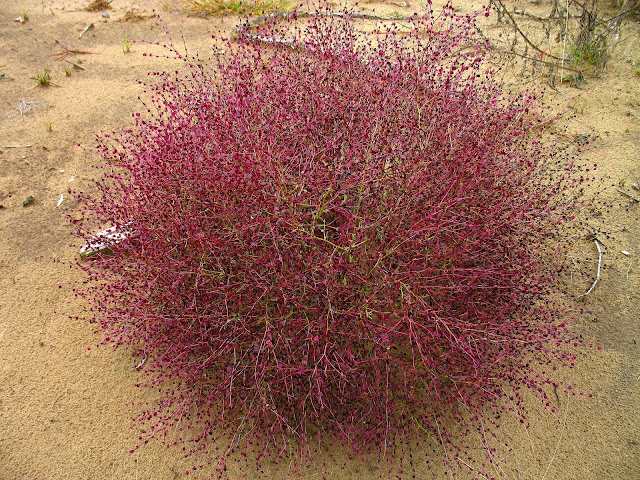The Jerusalem Artichoke (Helianthus tuberosus) is not quite the last flower of summer (Witch Hazel and Monkshood are still to bloom), but I know that when this sunflower opens its brilliant yellow flowers atop gigantic stalks, the wildflower season is drawing to a close. These were standing tall along the Kayaderosseras Creek. (The little Candystripe Leafhopper lent a lovely touch!)
The New England Asters (Symphyotrichum novae-angliae) are also in their glory along the creek, and this one looked extra glorious when a ray of sun lit up its vivid disk flowers against the shadows of a neighboring tree.
Since I've seen so few Monarch Butterflies this year and last, I was truly delighted to see this pretty thing feeding among the asters.
I explored the Louden Road Nature Preserve behind the Saratoga Mall in Wilton this week, not expecting to find much color in what is a deeply shaded oak/pine woods. But in this same woods Sassafras trees were also remarkably abundant. And some of them still held their beautiful blue-black fruits perched atop cherry-red pedicels.
My friends in the Thursday Naturalists and I twice visited the Woodlawn Preserve in Schenectady, a pine-bush habitat remarkable for the hundreds of gorgeous Fringed Gentians (Gentianopsis crinita) that fill an open damp meadow. Is there any flower to match its radiant blueness?
Well, the tiny Blue Curls flowers (Trichostema dichotomum) are also radiantly blue, but you have to look really close to enjoy their remarkable beauty and intriguing structure, with their distinctive arching anthers curling over spotted lower lips.
An even closer looks reveals the charming little seed cups that form after the Blue Curls flowers fall.
If you want to see the beautiful little orchid called Nodding Ladies' Tresses (Spiranthes cernua), that Woodlawn Preserve is where you should visit, since we found them by the dozen there.
The Woodlawn Preserve is also the only place I have ever found the interesting plant called Seedbox (Ludwigia alternifolia). I have never seen it in bloom with its four-parted yellow flowers, but its seeds are the most remarkable feature of this member of the Evening Primrose Family. They form these perfect little squared-off boxes, the inspiration for the plant's common name.
The driest, sandiest, most barren soils of the Woodlawn Preserve are where we found a number of these odd, tumbleweed-like plants called Winged Pigweed (Cycloloma atriplicifolium). These bushy masses of branches bearing tiny, winged, disk-shaped flowers all sprout from a single stem, which eventually breaks off to allow the plant to roll away with the wind, spreading its seeds as it tumbles.
Of course, when I go looking for flowers, I always encounter some interesting critters as well. This green-eyed clubtail dragonfly was perched along the muddy banks of the Kayaderosseras Creek. I would not venture a guess as to its species, since clubtails are especially difficult to distinguish.
Close by along the creekbed, I startled this Leopard Frog, whose emerald-green color caused it to stand out against the background of dark mud.
These tiny yellow Oleander Aphids seem to like milkweed as much as oleanders, since that's where I often find them. (I don't think that oleanders grow wild in this part of the country, anyway.) This cluster occupied a seedpod of Swamp Milkweed. I'm thinking this must be a relatively new population, due to the varied sizes. This cluster of aphids began when a single winged female aphid landed on the pod and produced a clone of herself without mating with a male. Then the clone produced a second clone, and that clone did the same, and on and on. The little ones are the newly cloned, and they will continue the process of cloning themselves. I do not know what forces limit the size of a single plant's population of aphids. I can't believe how cute these little critters are!
The same cloning system creates clumps of Wooly Alder Aphids, which I found feeding on alder twigs as I paddled along the banks of the Hudson River this week. This species of aphids exudes a white waxy "fur" to protect itself from the wet and cold, as well as to dissuade predators. As the season winds down, these female clones will produce a generation of aphids with wings, including some males, which will then fly away to find mates and lay eggs on their primary host trees, Silver Maples.
Watch for the winged form of the Wooly Alder Aphid this month and next, as these wee little baby-blue bugs with their fluffy "skirts" fly about seeking mates. Sometimes called Fairy Flies, they look like tiny bits of blue fluff wafting in the air.















6 comments:
You find the most amazing marvels!
I learn so much from your blog that I see something I recognize on most of my own nature walks. Recently I saw hundreds of Nodding Ladies Tresses and knew instantly what they were. Thank you for helping me to keep my eyes open.
I am grateful to have found your blog when I was searching for hiking spots in Saratoga County. The beauty you uncover is amazing not to mention your photography and writing skills. Thank you for sharing your found treasures.
Between the "Fairy Fly" and the Winged Pigweed, you have solved two of the largest natural mysteries I've been wondering about for the last few years. Thanks so much!
What a great group of interesting things you've seen!
Oh, my dear readers, your generous comments remind me that my blog can be useful to others, as well as a sometimes dutiful chore for myself. Some days I feel I have written and posted enough, that there is nothing new I could say or show, but then I go out for a walk or a paddle and I am once again stunned into a delight I feel compelled to share. Thank you for your encouraging gratitude.
Post a Comment